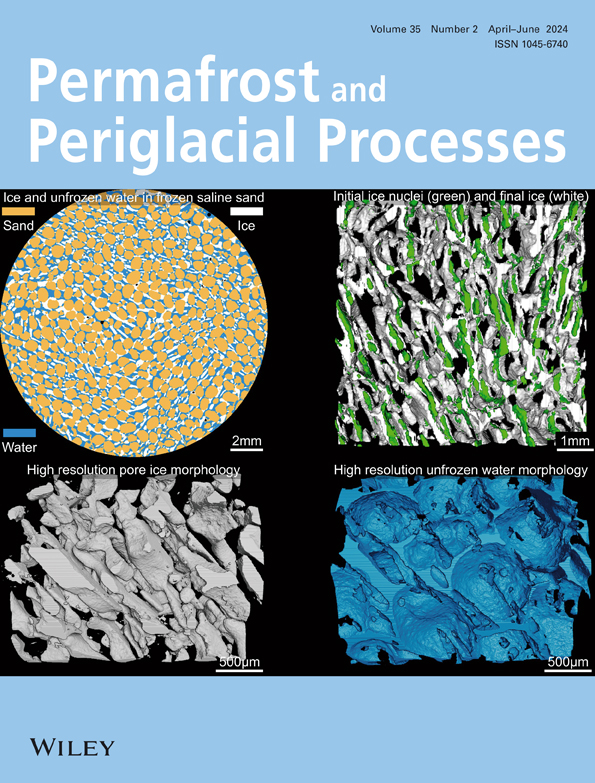Topography and canopy cover influence soil organic carbon composition and distribution across a forested hillslope in the discontinuous permafrost zone
IF 3.3
3区 地球科学
Q2 GEOGRAPHY, PHYSICAL
引用次数: 0
Abstract
Topography and canopy cover influence ground temperature in warming permafrost landscapes, yet soil temperature heterogeneity introduced by mesotopographic slope positions, microtopographic differences in vegetation cover, and the subsequent impact of contrasting temperature conditions on soil organic carbon (SOC) dynamics are understudied. Buffering of permafrost‐affected soils against warming air temperatures in boreal forests can reflect surface soil characteristics (e.g., thickness of organic material) as well as the degree and type of canopy cover (e.g., open cover vs. closed cover). Both landscape and soil properties interact to determine meso‐ and microscale heterogeneity of ground warming. We sampled a hillslope catena transect in a discontinuous permafrost zone near Fairbanks, Alaska, to test the small‐scale (1 to 3 m) impacts of slope position and cover type on soil organic matter composition. Mineral active layer samples were collected from backslope, low backslope, and footslope positions at depths spanning 19 to 60 cm. We examined soil mineralogical composition, soil moisture, total carbon and nitrogen content, and organic mat thickness in conjunction with an assessment of SOC composition using Fourier‐transform ion cyclotron resonance mass spectrometry (FT‐ICR‐MS). Soils in the footslope position had a higher relative contribution of lignin‐like compounds, whereas backslope soils had more aliphatic and condensed aromatic compounds as determined using FT‐ICR‐MS. The effect of open versus closed tree canopy cover varied with the slope position. On the backslope, we found higher oxidation of molecules under open cover than closed cover, indicating an effect of warmer soil temperature on decomposition. Little to no effect of the canopy was observed in soils at the footslope position, which we attributed, in part, to the strong impact of soil moisture content in SOC dynamics in the water‐gathering footslope position. The thin organic mat under open cover on the backslope position may have contributed to differences in soil temperature and thus SOC oxidation under open and closed canopies. Here, the thinner organic mat did not appear to buffer the underlying soil against warm season air temperatures and thus increased SOC decomposition as indicated by the higher oxidation of SOC molecules and a lower contribution of simple molecules under open cover than the closed canopy sites. Our findings suggest that the role of canopy cover in SOC dynamics varies as a function of landscape position and soil properties, namely, organic mat thickness and soil moisture. Condition‐specific heterogeneity of SOC composition under open and closed canopy cover highlights the protective effect of canopy cover for soils on backslope positions.地形和冠层覆盖对断续多年冻土带森林坡地土壤有机碳组成和分布的影响
地形和冠层覆盖影响变暖多年冻土景观中的地面温度,但由中地形斜坡位置、植被覆盖的微观地形差异引入的土壤温度异质性,以及对比温度条件对土壤有机碳(SOC)动态的后续影响,研究不足。北方森林中受永久冻土影响的土壤对变暖空气温度的缓冲可以反映地表土壤特征(例如有机物质的厚度)以及冠层覆盖的程度和类型(例如开放覆盖与封闭覆盖)。景观和土壤特性相互作用,决定了地面变暖的中尺度和微观尺度异质性。我们在阿拉斯加费尔班克斯附近的一个不连续的永久冻土区对一个山坡连环样带进行了采样,以测试小尺度(1-3 m) 坡位和覆盖类型对土壤有机质组成的影响。从19至60米深度的后坡、低后坡和脚坡位置采集矿物活性层样品 cm。我们检查了土壤矿物学成分、土壤水分、总碳和氮含量以及有机垫厚度,并使用傅里叶变换离子回旋共振质谱法(FT‐ICR‐MS)评估了SOC成分。使用FT‐ICR‐MS测定,脚坡位置的土壤中木质素类化合物的相对贡献更高,而后坡土壤中脂族和稠合芳香族化合物的贡献更多。开放式和封闭式树冠覆盖的影响随坡度的不同而不同。在后坡上,我们发现开放覆盖下的分子氧化程度高于封闭覆盖,这表明土壤温度升高对分解的影响。在坡脚位置的土壤中几乎没有观察到冠层的影响,我们将其部分归因于土壤水分含量对集水坡脚位置SOC动态的强烈影响。后坡位置开放覆盖下的薄有机垫可能导致土壤温度差异,从而导致开放和封闭遮篷下的SOC氧化。在这里,较薄的有机垫似乎不能缓冲下层土壤免受暖季气温的影响,因此SOC分解增加,这表明SOC分子在开放覆盖下的氧化程度较高,简单分子在封闭冠层下的贡献较低。我们的研究结果表明,冠层覆盖在SOC动态中的作用随着景观位置和土壤性质(即有机垫厚度和土壤湿度)的变化而变化。开放和封闭冠层覆盖下SOC组成的特定条件异质性突出了冠层覆盖对后坡位置土壤的保护作用。
本文章由计算机程序翻译,如有差异,请以英文原文为准。
求助全文
约1分钟内获得全文
求助全文
来源期刊
CiteScore
9.70
自引率
8.00%
发文量
43
审稿时长
>12 weeks
期刊介绍:
Permafrost and Periglacial Processes is an international journal dedicated to the rapid publication of scientific and technical papers concerned with earth surface cryogenic processes, landforms and sediments present in a variety of (Sub) Arctic, Antarctic and High Mountain environments. It provides an efficient vehicle of communication amongst those with an interest in the cold, non-glacial geosciences. The focus is on (1) original research based on geomorphological, hydrological, sedimentological, geotechnical and engineering aspects of these areas and (2) original research carried out upon relict features where the objective has been to reconstruct the nature of the processes and/or palaeoenvironments which gave rise to these features, as opposed to purely stratigraphical considerations. The journal also publishes short communications, reviews, discussions and book reviews. The high scientific standard, interdisciplinary character and worldwide representation of PPP are maintained by regional editorial support and a rigorous refereeing system.

 求助内容:
求助内容: 应助结果提醒方式:
应助结果提醒方式:


